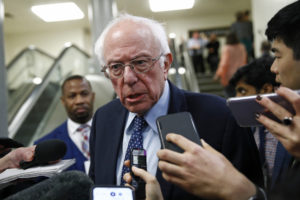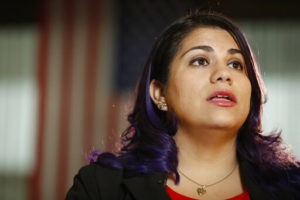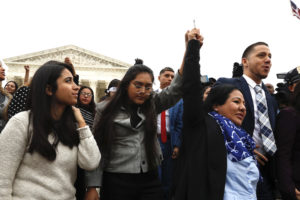Trump Proposal Would Change Priorities of Green Card System
The plan would favor people with high-level skills, degrees and job offers instead of relatives of those already in the country.WASHINGTON—After years of setbacks and stalemates, President Donald Trump will lay out yet another immigration plan as he tries to convince the American public and lawmakers that the nation’s legal immigration system should be overhauled.
The latest effort, spearheaded by Trump’s son-in-law and senior adviser, Jared Kushner, focuses on beefing up border security and rethinking the green card system so that it would favor people with high-level skills, degrees and job offers instead of relatives of those already in the country.
A shift to a more merit-based system prioritizing high-skilled workers would mark a dramatic departure from the nation’s largely family-based approach, which officials said gives roughly 66% of green cards to those with family ties and only 12% based on skills.
But the plan, which is set to be rolled out on Thursday but has yet to be embraced by Trump’s own party — let alone Democrats — faces an uphill battle in Congress. Efforts to overhaul the immigration system have gone nowhere for three decades amid deeply divided Republicans and Democrats. Prospects for an agreement seem especially bleak as the 2020 elections near, though the plan could give Trump and the GOP a proposal to rally behind, even if talks with Democrats go nowhere.
The plan does not address what to do about the millions of immigrants already living in the country illegally, including hundreds of thousands of young “Dreamers” brought to the U.S. as children — a top priority for Democrats. Nor does it reduce overall rates of immigration, as many conservative Republicans would like to see.
Trump will nonetheless deliver a Rose Garden speech Thursday throwing his weight behind the plan, which has thus far received mixed reviews from Republicans in the Senate.
In briefings Wednesday that attracted dozens of journalists, administration officials said the plan would create a points-based visa system, similar to those used by Canada and other countries.
The officials, who spoke on condition of anonymity to outline the plan before Trump’s announcement, said the U.S. would award the same number of green cards as it now does. But far more would go to exceptional students so they can remain in the country after graduation, professionals and people with high-level and vocational degrees. Factors such as age, English language ability and employment offers would also be taken into account.
Far fewer green cards would be given to people with relatives already in the U.S. and 57% versus the current 12% would be awarded based on merit. The diversity visa lottery, which offers green cards to citizens of countries with historically low rates of immigration to the U.S., would be eliminated. Officials insisted diversity would be addressed in other ways.
The officials offered fewer specifics on border security, which is expected to remain a key focus for Trump as he campaigns for reelection. Trump has been furiously railing against the spike in Central American migrant families trying to enter the country, and he forced a government shutdown in a failed effort to fulfill his 2016 promise to build a southern border wall.
As part of the plan, officials want to shore up ports of entry to ensure all vehicles and people are screened and to create a self-sustaining fund, paid for with increased fees, to modernize ports of entry.
The plan also calls for building border wall in targeted locations and continues to push for an overhaul to the U.S. asylum system, with the goal of processing fewer applications and removing people who don’t qualify faster.
While the officials insisted their effort was not a “political” plan, they nonetheless framed it as one they hoped Republicans would unite behind, making clear to voters what the party is “for.”
“I don’t think it’s designed to get Democratic support as much as it is to unify the Republican Party around border security, a negotiating position,” said Sen. Lindsey Graham, R-S.C., a close ally of the White House.
Indeed, the plan drew immediate criticism from Democrats as well as immigration activists, who remain deeply skeptical of Trump after past negotiation failures.
Democrats and some Republicans tried crafting a compromise with Trump last year that would have helped young Dreamer immigrants and added money for border security. But those talks collapsed over White House demands to curb legal immigration and a dramatic Senate showdown in which lawmakers rejected three rival proposals that aligned with the “four pillars” immigration plan Trump unveiled that year.
Senate Minority Leader Chuck Schumer criticized the White House for failing to engage in talks with Democrats over the latest proposal.
“Don’t come up with a plan that Stephen Miller rubber stamps and say, ‘Now, pass it.’ It’s not going to happen,” Schumer, D-N.Y., said, referring to Trump’s hard-line policy adviser.
Lisa Koop, director of legal services at the National Immigrant Justice Center, also criticized the various planks of the proposal, including its failure to address those brought to the U.S. illegally as children who are currently protected from deportation by the Deferred Action for Childhood Arrivals policy, or DACA, which Trump has tried to end.
“A plan that forces families apart, limits access to asylum and other humanitarian relief, and doesn’t contemplate a path to citizenship for DACA recipients and other undocumented community members is clearly a political stunt intended to posture rather than problem-solve,” she said.
Mark Krikorian, executive director of the Center for Immigration Studies, which advocates for lower immigration rates, applauded a “very positive effort” on legal immigration, but said it was “undermined by the embrace of the current very high level of immigration.”
Republicans on the Hill, too, voiced skepticism, even as administration officials insisted the plan had been embraced by those who briefed on it. A PowerPoint presentation shared with reporters Wednesday referred to the plan as “The Republican Proposal,” even though many GOP members had yet to see it.
Graham, who rolled out his own proposal Wednesday to address the recent flood of migrants seeking asylum at the U.S.-Mexico border, said he had advised Trump to try to cut a new deal with Democrats and believed Trump was open to that.
“I am urging the president to lead us to a solution,” he said.
Your support matters…Independent journalism is under threat and overshadowed by heavily funded mainstream media.
You can help level the playing field. Become a member.
Your tax-deductible contribution keeps us digging beneath the headlines to give you thought-provoking, investigative reporting and analysis that unearths what's really happening- without compromise.
Give today to support our courageous, independent journalists.








You need to be a supporter to comment.
There are currently no responses to this article.
Be the first to respond.